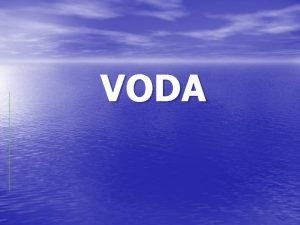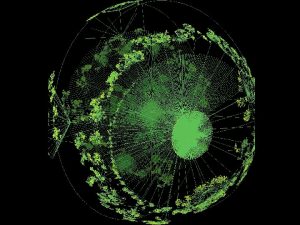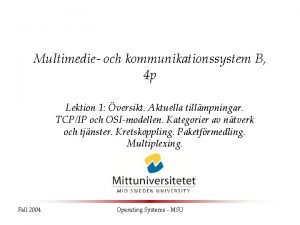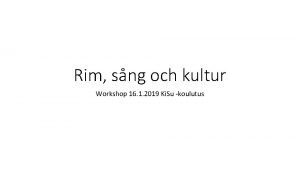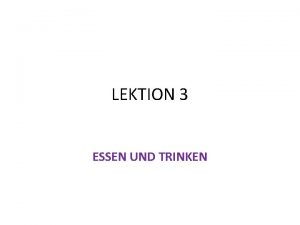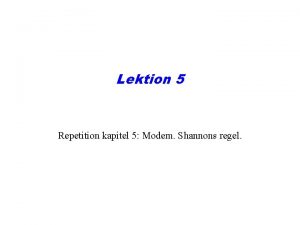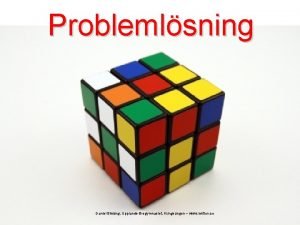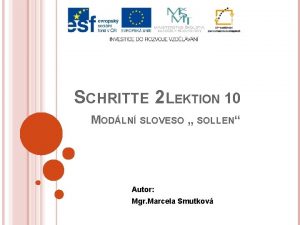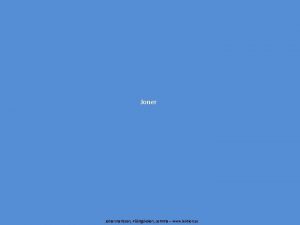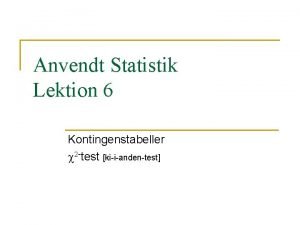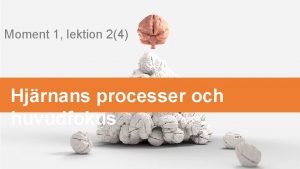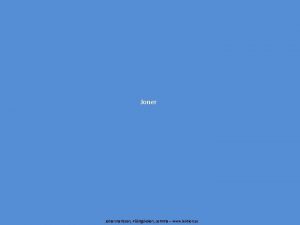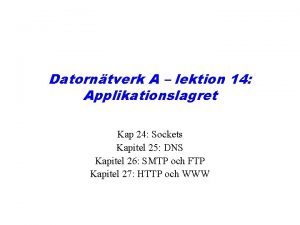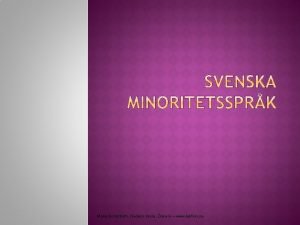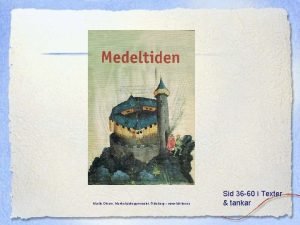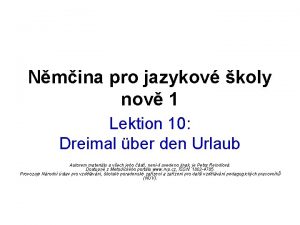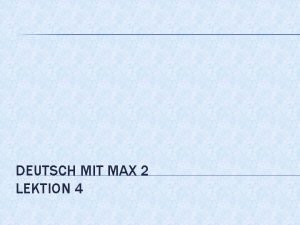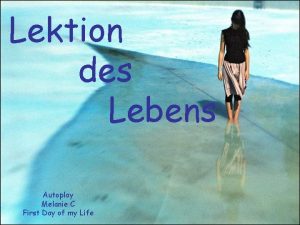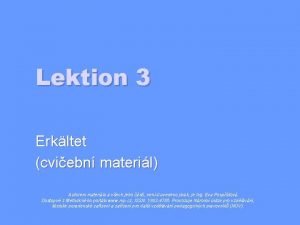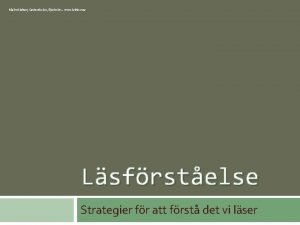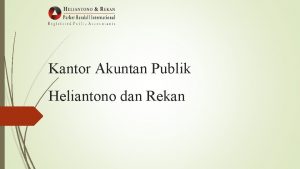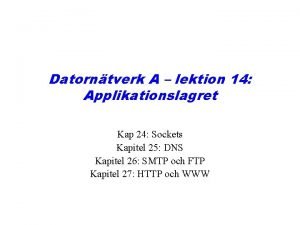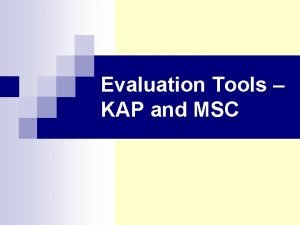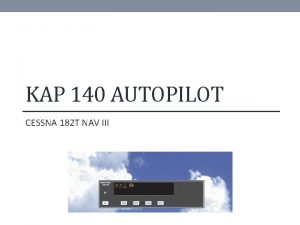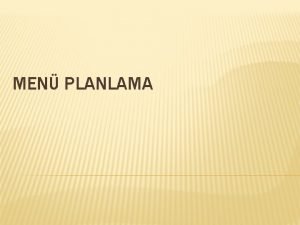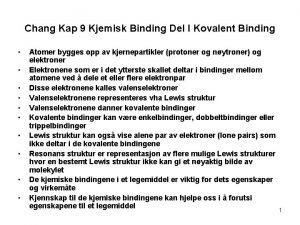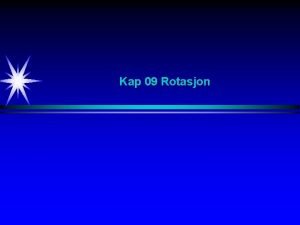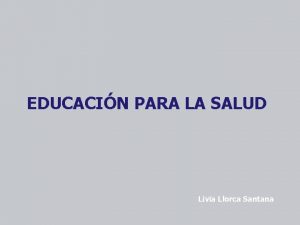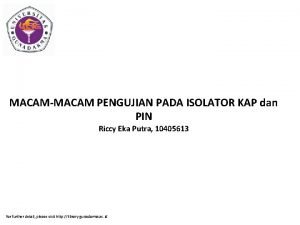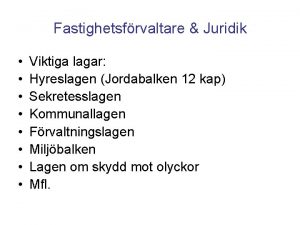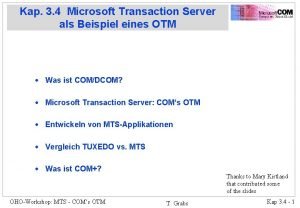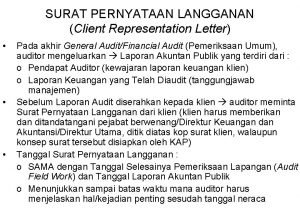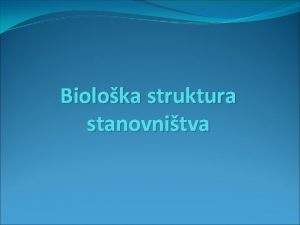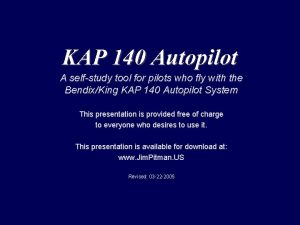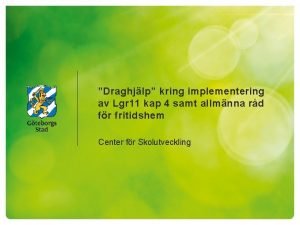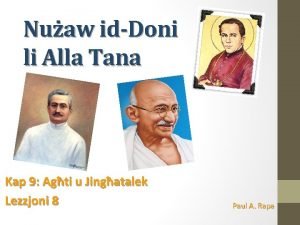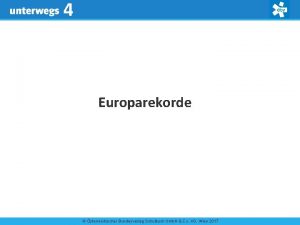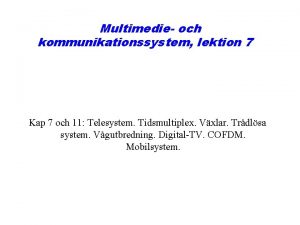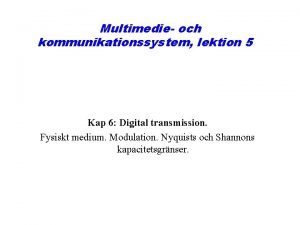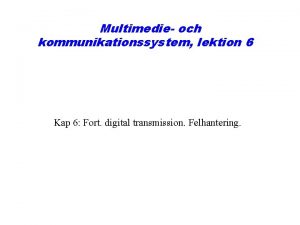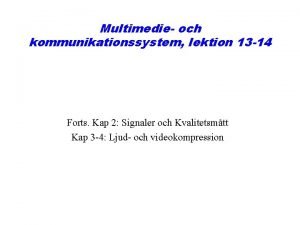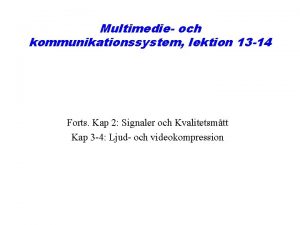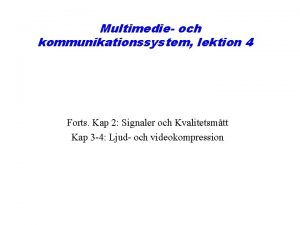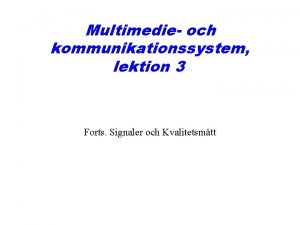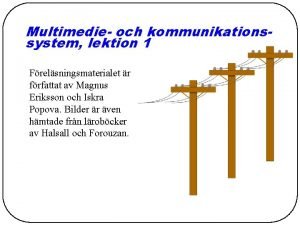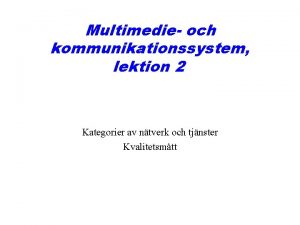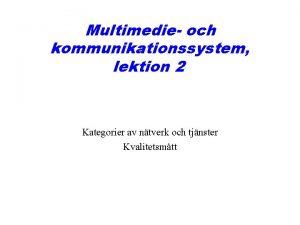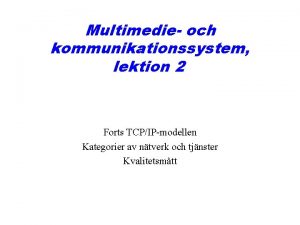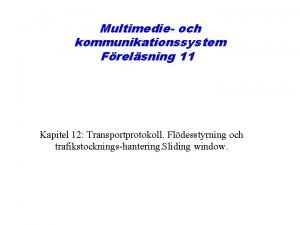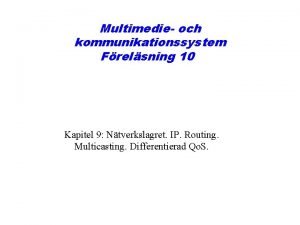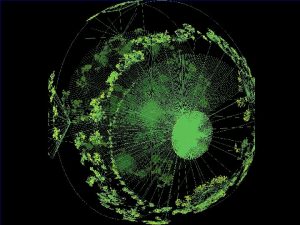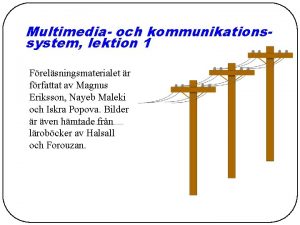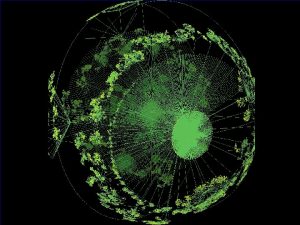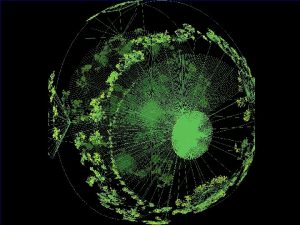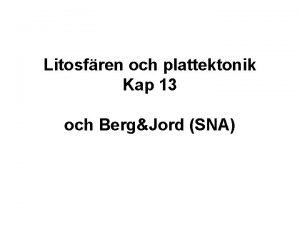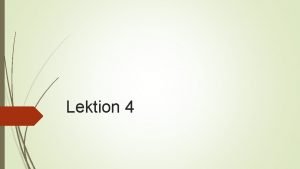Multimedie och kommunikationssystem lektion 5 Kap 6 Digital
























































- Slides: 56

Multimedie- och kommunikationssystem, lektion 5 Kap 6: Digital transmission. Fysiskt medium. Modulation. Nyquists och Shannons kapacitetsgränser.

Figure 6. 3 Copper wire transmission media: (a) twowire and multiwire open lines; (b) unshielded twisted pair (UTP);

Figure 6. 3 Copper wire transmission media: (c) shielded twisted pair (STP); (d) coaxial cable.

Figure 6. 4 (b) Optical fiber transmission modes.

Figure 6. 2 Effect of attenuation, distortion, and noise on transmitted signal.

Figure 6. 7 Sources of signal impairment.

Example 6. 3


Asynchronous transmission

Exempel på asynkron serie-kommunikation: RS 232 C (”com-porten”)

NRZ = Non-return to zero.

In NRZ-L the level of the signal is dependent upon the state of the bit. In NRZ-I the signal is inverted if a 1 is encountered.

Bit synchronization RZ encoding

Figure 4. 10 Manchester encoding

Figure 4. 11 Differential Manchester encoding

Figure 6. 15 Synchronous transmission clock encoding methods: (a) Manchester; (b) differential Manchester.

Figure 4. 12 Bipolar AMI encoding

Example 6. 6: Clock rate deviation


Figure 5. 26 Analogue amplitude modulation

Figure 5. 29 Analogue frequency modulation

Digitala modulationsmetoder Binär signal ASK = Amplitude Shift Keying (AM) FSK = Frequency Shift Keying (FM) PSK = Phase Shift Keying (PSK)

Exempel 1: Till höger visas fyra symboler som används av ett s. k. 4 PSKmodem (PSK=Phase Shift Keying). De fyra symbolerna representerar bitföljderna 00, 01, 11 resp 10. a) Nedan visas utsignalen från det sändande modemet. Vilket meddelande, dvs vilken bitsekvens, överförs? 1 0 -1 1 Svar: 1/1 ms = 1000 symber per sekund = 1 kbaud. c) Vad är bithastigheten i bit per sekund (bps)? Svar: 2000 bps. 0 0. 5 1 time [milliseconds] 01 0 -1 Svar: 11 00 10 10. b) Tidsaxeln är graderad i tusendels sekunder. Vad är symbolhastigheten i baud eller symboler/sekund? 00 1 0 0. 5 1 time [milliseconds] 11 0 -1 1 0 0. 5 1 time [milliseconds] 10 0 -1 0 0. 5 1 time [milliseconds]

Exempel 2: Nedan visas åtta symboler som används av ett s. k. 8 QAM-modem (QAM=Quadrature Amplitude Modulation). Symbolerna i övre raden representerar bitföljderna 000, 001, 011 resp 010 (från vänster till höger). Undre raden representerar 100, 101, 111 resp 110.

Forts exempel 2:

Digital modulation q För att överföra N bit/symbol krävs M=2 N q Vid M symboler överförs N=log 2 M bit/symbol. q Baudrate fs= antal symboler per sekund. Enhet: baud eller symboler/sekund. q Symbollängd Ts= 1/fs. fs= 1/Ts q Bitrate R = datahastighet. Enhet: bps eller bit/s. q R= fslog 2 M

Table 5. 1 Bit and baud rate comparison Modulation Units Bits/Symbol Baud rate Bit Rate Bit 1 N N 4 -PSK, 4 -QAM Dibit 2 N 2 N 8 -PSK, 8 -QAM Tribit 3 N 3 N 16 -QAM Quadbit 4 N 4 N 32 -QAM Pentabit 5 N 5 N 64 -QAM Hexabit 6 N 6 N 128 -QAM Septabit 7 N 7 N 256 -QAM Octabit 8 N 8 N ASK, FSK, 2 -PSK

Example 12 Compute the baud rate for a 72, 000 -bps 64 -QAM signal. Solution A 64 -QAM signal has 6 bits per signal unit since log 2 64 = 6. Thus, 72000 / 6 = 12, 000 baud

Figure 5. 9 BPSK constellation

Figure 5. 11 The 4 -PSK characteristics

Figure 5. 16 16 -QAM constellations

Figure 5. 13 Relationship between baud rate and bandwidth in ASK, PSK, QAM (not FSK) without pulse shaping Vid många modulationsformer t. ex. s. k. ASK, PSK, och QAM är signalens bandbredd = symbolhastigheten. Vid FSK är bandbredden vanligen större. Bandbredden kan minskas genom s. k. pulsformning.

Maximal kanalkapacitet enligt Nyquist

Example 6. 4: Nyquist maximum data rate

Shannons regel Kanalkapaciteten C är max antal bit per sekund vid bästa möjliga modulationsteknik och felrättande kodning: C = B log 2 (1+S/N), där B är ledningens bandbredd i Hertz (oftast ungefär lika med övre gränsfrekvensen), S är nyttosignalens medeleffekt i Watt och N (noice) är bruseffekten i Watt.

Example 6. 5: Shannon information capacity

Figure 6. 4 FDM (Frekvensdelningsmultiplex, frequency division multiplex) Exempel på FDM-teknik: ADSL-modem, kabel-TV-modem, trådlös kommunikation.

Figure 6. 5 FDM demultiplexing example

Example 3 Four data channels (digital), each transmitting at 1 Mbps, use a satellite channel of 1 MHz. Design an appropriate configuration using FDM Solution The satellite channel is analog. We divide it into four channels, each channel having a 250 -KHz bandwidth. Each digital channel of 1 Mbps is modulated such that each 4 bits are modulated to 1 Hz. One solution is 16 QAM modulation. Figure 6. 8 shows one possible configuration.

Figure 6. 8 Example 3

Example 4 The Advanced Mobile Phone System (AMPS) uses two bands. The first band, 824 to 849 MHz, is used for sending; and 869 to 894 MHz is used for receiving. Each user has a bandwidth of 30 KHz in each direction. The 3 KHz voice is modulated using FM, creating 30 KHz of modulated signal. How many people can use their cellular phones simultaneously? Solution Each band is 25 MHz. If we divide 25 MHz into 30 KHz, we get 833. In reality, the band is divided into 832 channels.

6. 2 WDM Wave Division Multiplexing (Fiber optics)

Figure 6. 10 WDM = Wave division multiplexing En laser per kanal Fiberkabel

Figure 6. 11 Prisms in WDM multiplexing and demultiplexing

Figure 6. 12 TDM, Tidsmultiplex (Time Division multiplex)

Note: TDM is a digital multiplexing technique to combine data.

Figure 6. 13 TDM frames

Note: In a TDM, the data rate of the link is n times faster, and the unit duration is n times shorter.

Figure 6. 14 Interleaving

Example 6 Four channels are multiplexed using TDM. If each channel sends 100 bytes/s and we multiplex 1 byte per channel, show the frame traveling on the link, the size of the frame, the duration of a frame, the frame rate, and the bit rate for the link. Solution The multiplexer is shown in Figure 6. 15.

Figure 6. 15 Example 6

Example 7 A multiplexer combines four 100 -Kbps channels using a time slot of 2 bits. Show the output with four arbitrary inputs. What is the frame rate? What is the frame duration? What is the bit rate? What is the bit duration? Solution Figure 6. 16 shows the output for four arbitrary inputs.

Figure 6. 16 Example 7

Figure 6. 18 DS hierarchy

Figure 6. 19 T-1 line for multiplexing telephone lines

Table 6. 2 E line rates E Line Rate (Mbps) Voice Channels E-1 2. 048 30 E-2 8. 448 120 E-3 34. 368 480 E-4 139. 264 1920
 Kap kap kape voda
Kap kap kape voda Wide area kommunikationssystem
Wide area kommunikationssystem Plektion
Plektion Hinduism och buddhism skillnader
Hinduism och buddhism skillnader Tjock och smal liten och stor
Tjock och smal liten och stor Lektion 3 essen und trinken
Lektion 3 essen und trinken Kapitel 5 lektion a answers
Kapitel 5 lektion a answers Lektion se
Lektion se Schritte international 2 test zu lektion 10
Schritte international 2 test zu lektion 10 Flouridjon
Flouridjon Lektion 2
Lektion 2 Ki i anden test
Ki i anden test Huvudfokus
Huvudfokus Flouridjon
Flouridjon Lektion 14
Lektion 14 Lektion,se
Lektion,se Helvetestratten dante
Helvetestratten dante Urlaub člen
Urlaub člen Lektion 4
Lektion 4 Lektion se
Lektion se Lektion se
Lektion se Lektion des lebens
Lektion des lebens Infinitiv
Infinitiv Malin nielsen
Malin nielsen Guten tag slike
Guten tag slike Kap heliantono dan rekan surabaya
Kap heliantono dan rekan surabaya Kap 24
Kap 24 Kap tools
Kap tools Kap 140 autopilot
Kap 140 autopilot Likviditetsbudget
Likviditetsbudget Tabldot menüde 2. grup
Tabldot menüde 2. grup Kap kut
Kap kut Sawadee krap
Sawadee krap Kovalent kap
Kovalent kap Treghetsmoment kule
Treghetsmoment kule Modelo kap educacion para la salud
Modelo kap educacion para la salud Kap dan pin
Kap dan pin 12 kap jb
12 kap jb Tpcall
Tpcall Isi client representation letter
Isi client representation letter Kap modell
Kap modell Mlado zrelo i staro stanovnistvo
Mlado zrelo i staro stanovnistvo Kap 140 autopilot ils approach
Kap 140 autopilot ils approach Lgr 11 kapitel 4
Lgr 11 kapitel 4 Kap 12
Kap 12 Kap 9
Kap 9 Menü monotonluğu nedir
Menü monotonluğu nedir överlåtelsbesiktning
överlåtelsbesiktning Kap framework
Kap framework Kap lithinon
Kap lithinon Data encoding and transmission
Data encoding and transmission Unique features of digital markets
Unique features of digital markets Digital adalah
Digital adalah E-commerce: digital markets, digital goods
E-commerce: digital markets, digital goods Digital market and digital goods
Digital market and digital goods Data encoding techniques
Data encoding techniques Digital data digital signals
Digital data digital signals
